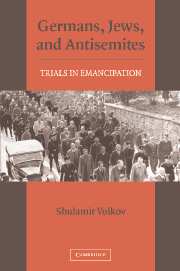Book contents
- Frontmatter
- Contents
- Preface
- Prologue: My Father Leaves His German Homeland
- PART I INTERPRETING THE DANGER SIGNS
- PART II ANTISEMITISM AS A CULTURAL CODE
- PART III THE GERMAN-JEWISH PROJECT OF MODERNITY
- 8 Excursus on Minorities in the Nation-State
- 9 Climbing Up the Social Ladder
- 10 Paradoxes of Becoming Alike
- 11 Jewish Success in Science
- 12 The Ambivalence of Bildung
- 13 Forces of Dissimilation
- 14 Inventing Tradition
- Epilogue: Closing the Circle
- Index
12 - The Ambivalence of Bildung
Published online by Cambridge University Press: 05 June 2012
- Frontmatter
- Contents
- Preface
- Prologue: My Father Leaves His German Homeland
- PART I INTERPRETING THE DANGER SIGNS
- PART II ANTISEMITISM AS A CULTURAL CODE
- PART III THE GERMAN-JEWISH PROJECT OF MODERNITY
- 8 Excursus on Minorities in the Nation-State
- 9 Climbing Up the Social Ladder
- 10 Paradoxes of Becoming Alike
- 11 Jewish Success in Science
- 12 The Ambivalence of Bildung
- 13 Forces of Dissimilation
- 14 Inventing Tradition
- Epilogue: Closing the Circle
- Index
Summary
George Mosse regarded the Jews as the ultimate representatives and last defenders of the German humanistic culture at its best. By the late eighteenth century, he claimed, Jews had collectively embraced Bildung, a compound cultural ideal that represented the essence of European Enlightenment. Defined by luminaries such as Lessing, Goethe, Schiller, and Humboldt, together with other, less illustrious figures, who all worked out its precise content, the Bildung ideal was then formulated and given individual as well as communal meanings. It emphasized rationality and a vision of humanity acting under its guidance. Bildung meant above all the process of individual self-development, gradually manifesting man's – indeed usually not woman's – spiritual potential and his capacity to become a free, creative, and autonomous person living in harmony with like-minded men in a spirit of tolerance, solidarity, and friendship. As in the special case of science discussed in the previous chapter, this general ideal held the promise of total openness and, in its radical version, even the promise of full civil equality among all who were ready to commit themselves to its principles, regardless of race or class.
While this was the point of departure, Mosse continued, things began to go wrong soon afterward. While at first it seemed that the promise embodied in Bildung was being fulfilled, hopes were soon shattered. Jews could join the new community of Bildung, manifesting their deep dedication and extraordinary talent, but a fundamental conflict within the educated camp gradually complicated matters.
- Type
- Chapter
- Information
- Germans, Jews, and AntisemitesTrials in Emancipation, pp. 248 - 255Publisher: Cambridge University PressPrint publication year: 2006



